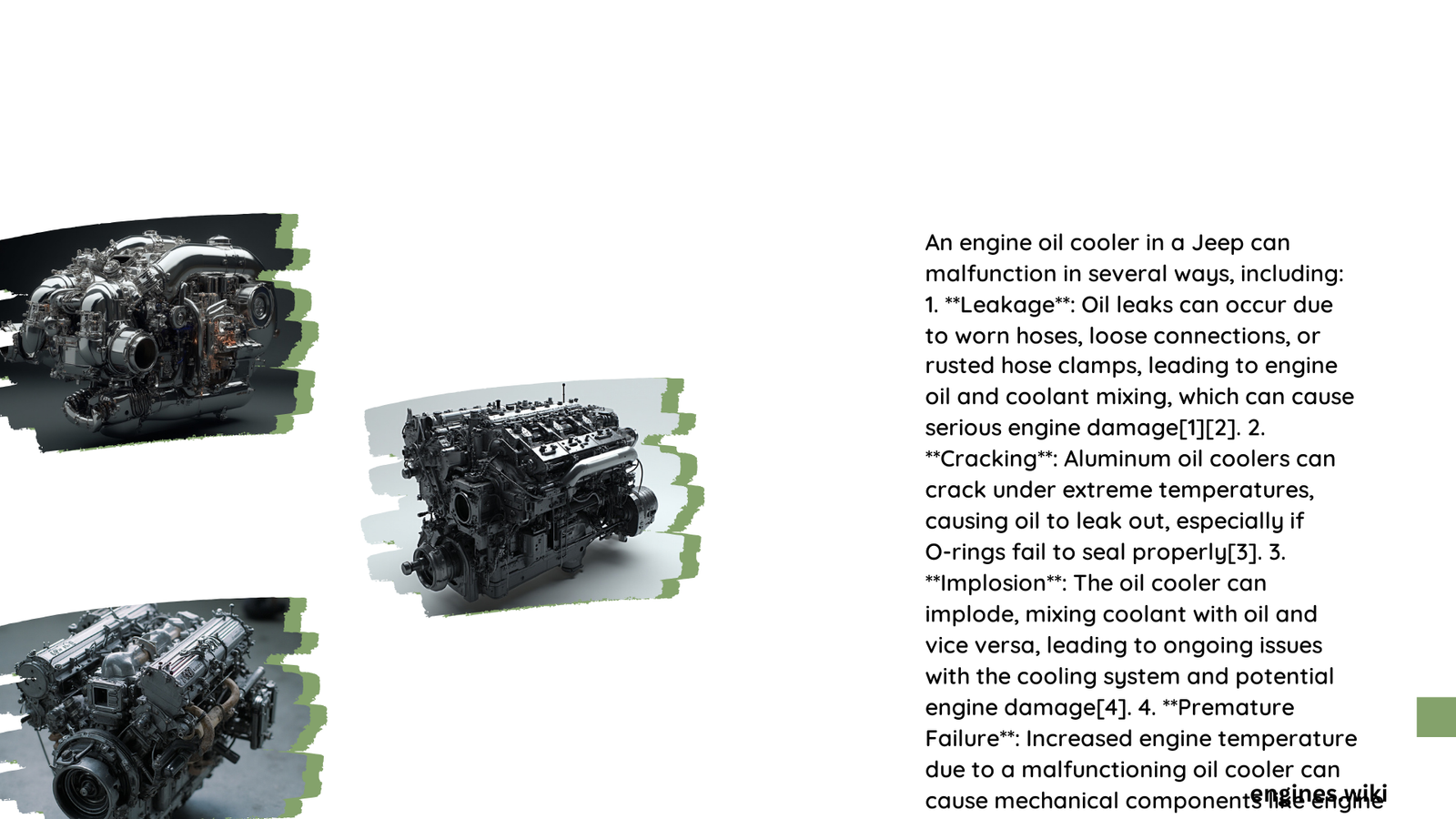Engine oil coolers in Jeeps are crucial components that can experience various issues, including leaks, overheating, and clogging. These problems can lead to engine damage, reduced performance, and costly repairs. Common causes include degradation of seals and o-rings, especially in Pentastar V6 engines. Leaks often occur around the oil cooler core, oil lines, and connections to the engine. Understanding these potential issues is essential for Jeep owners to maintain their vehicle’s performance and longevity.
What Are the Common Causes of Oil Leaks in Jeep Engine Oil Coolers?
Oil leaks in Jeep engine oil coolers can stem from several sources:
- Degradation of seals and o-rings
- Wear and tear on oil cooler lines
- Damage to the cooler core
- Flattening of rubber o-rings against aluminum housing
These issues are particularly prevalent in Jeep models equipped with the Pentastar V6 engine. The oil ports on the cooler body, especially on the right side near the sensors, are prone to leaks due to the deterioration of rubber components over time.
How Does an Overheating Engine Oil Cooler Affect a Jeep’s Performance?

An overheating engine oil cooler can have severe consequences for a Jeep’s performance:
- Compromised oil viscosity and protective abilities
- Increased risk of engine damage
- Potential for clattering noises detected by the knock sensor
- Illumination of the check engine light
- Possible oil starvation leading to engine failure
The engine relies on a constant supply of properly cooled oil to function safely. When the oil cooler fails to maintain the correct oil temperature, it puts the entire engine at risk.
What Are the Implications of a Clogged Engine Oil Cooler in a Jeep?
A clogged engine oil cooler can lead to several serious issues:
| Issue | Consequence |
|---|---|
| Blocked oil flow | Prevents oil from returning to the oil pan |
| Low oil pressure | Triggers warning lights (e.g., low oil pressure lamp) |
| Increased oil temperatures | Exacerbates overheating problems |
| Engine damage | Due to lack of proper lubrication |
If left unresolved, these problems can result in significant engine damage and potentially costly repairs.
What Are the Failure Rates and Common Issues with Jeep Engine Oil Coolers?
Engine oil coolers in Jeeps are generally durable, but they can fail due to various factors:
- Collisions
- Lack of maintenance
- Severe operating conditions
Typically, these components don’t require replacement until around 100,000 miles or more. However, this can vary depending on the vehicle’s maintenance history and usage patterns.
For Jeep models with the Pentastar V6 engine, the oil filter housing assembly (which includes the oil cooler) is known for its high failure rates. These failures often result from:
- Inadequate seals
- Core plugs without O-rings
- Leaks around the back of the unit
- Issues with sensors and the base of the housing
What Are the Repair Costs and Procedures for a Faulty Jeep Engine Oil Cooler?
The average cost for replacing an engine oil cooler in a Jeep Wrangler ranges between $292 and $340. However, this cost can vary depending on the specific model and conditions.
The repair procedure typically involves:
- Removing the mounting hardware
- Disconnecting the oil lines
- Installing a new oil cooler
- Flushing the engine oil system
- Draining and refilling with clean oil
- Changing the oil filter
If the oil cooler is part of the radiator assembly, additional steps may be necessary, such as:
- Draining the cooling system
- Refilling it after the repair
How Can Jeep Owners Prevent Engine Oil Cooler Issues?
To prevent engine oil cooler problems in Jeeps, owners should:
- Follow the manufacturer’s recommended maintenance schedule
- Regularly inspect for oil leaks
- Use high-quality engine oil appropriate for the vehicle
- Address any warning signs promptly (e.g., check engine light, unusual noises)
- Consider preventive replacement of seals and o-rings in high-mileage vehicles
What Are the Warning Signs of a Failing Engine Oil Cooler in a Jeep?
Jeep owners should be aware of the following warning signs that may indicate a failing engine oil cooler:
- Visible oil leaks under the vehicle
- Low oil pressure warnings
- Engine overheating
- Unusual engine noises (e.g., knocking, ticking)
- Decreased engine performance
- Illuminated check engine light
- Oil in the coolant or coolant in the oil
Early detection of these symptoms can help prevent more severe engine damage and reduce repair costs.
How Does the Engine Oil Cooler Interact with Other Jeep Engine Components?
The engine oil cooler in a Jeep is an integral part of the engine’s lubrication and cooling system. It interacts with several other components:
- Oil pump: Circulates oil through the cooler
- Oil filter: Removes contaminants before oil enters the cooler
- Engine block: Receives cooled oil from the cooler
- Radiator: In some models, the oil cooler is integrated with the radiator
- Thermostat: Regulates oil flow through the cooler based on temperature
Understanding these interactions can help diagnose issues more accurately and appreciate the importance of maintaining the entire engine oil system.
By addressing these questions, Jeep owners can better understand what can go wrong with an engine oil cooler in their vehicle and take appropriate preventive measures to ensure optimal engine performance and longevity.
Reference:
1. Why Pentastar Oil Filter Housings Fail – Standard Ignition
2. Jeep Wrangler Engine Oil Cooler Replacement Cost – RepairPal.com
3. Oil Cooler Replaced. Thoughts on Failures. – Chrysler Minivan Forum
